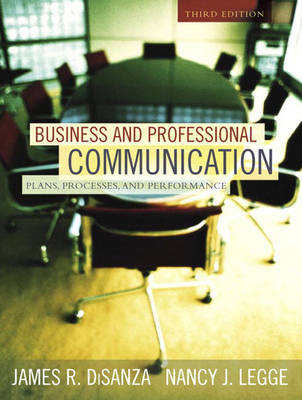
Business and Professional Communication
Pearson (Verlag)
978-0-205-45355-9 (ISBN)
- Titel erscheint in neuer Auflage
- Artikel merken
Preface.
1. The Role of Communication in Business and the Professions.
What Is Communication?
Goals of Communication.
Effective Communication Is Audience Centered.
Effective Communication is Strategic.
DYADIC AND GROUP COMMUNICATION.
2. The Employment Interview.
The Pre-Interview Stage.
The Interview Stage.
The Post-Interview Stage.
3. Listening and Feedback in Organizational Relationships.
Recall Listening.
Empathic Listening.
4. Interpersonal Politics: Power and Sexual Harassment in Organizations.
Interpersonal Power and Politics.
Building Interpersonal Networks: The Experience of Women and Minorities.
Sexual Harassment: A Gross Imbalance of Power.
5. Communicating in Organizational Groups and Teams.
The Leadership Role.
Membership Competencies in Groups and Teams.
Decision Making in Group and Team Meetings.
Conflict in Groups and Teams.
CREATING A PROFESSIONAL PRESENTATION.
6. Considering Audience Feedback.
Analyze the Situation.
Analyze Listener Characteristics.
Techniques for Analyzing the Audience.
7. Preparing and Delivering Presentations.
Decide on the General Purpose.
Select a Topic.
Develop the Specific Purpose Statement.
Develop the Main Idea Statement.
Gather Supporting Material.
Research the Topic.
Apply the Information Learned from the Audience Analysis.
Structure the Main Ideas in the Body of the Speech.
Outline the Speech.
Develop the Introduction and Conclusion.
Rehearsal and Delivery Considerations.
8. Creating and Using Visual Aids.
Types of Visual Aids.
Presenting Visual Aids to the Audience.
Computer-Generated Graphics.
TYPES OF BUSINESS AND PROFESSIONAL PRESENTATIONS.
9. Technical Presentations.
Understanding the Audience for Technical Information.
General Guidelines for Communicating Technical Information.
Overcoming Obstacles to Shared Meaning.
Structuring the Technical Presentation.
10. Proposal Presentations.
Audience Analysis for Persuasive Proposals.
Proposal Structures.
Developing Persuasive Arguments.
Outlining Your Points to Show Logical Relationships.
Developing Effective Credibility Appeals.
Developing Effective Emotional Appeals.
11. Sales Presentations.
The Significance of Sales Presentations in Business and the Professions.
Audience Analysis for Sales Presentations.
Visual Aids for Sales Presentations.
Content Considerations for Sales Presentations.
Delivering the Sales Presentation.
Structuring the Sales Presentation.
12. Risk Communication.
The Significance of Risk Communication in Business and Government.
The Scientific Process of Risk Analysis.
Audience Perceptions of Risk.
Credibility and the Process of Risk Communication.
Creating Risk Messages.
Formatting Risk Communication Messages
13. Crisis Communication.
The Significance of Crisis Communication in Businesses and the Professions.
The Components of Crisis Communication.
Forming a Crisis Management Team and Precrisis Planning.
Communication Responses to Organizational Crisis.
Effectively Employing Crisis Communication Strategies.
Structuring Organizational Crisis Communication.
Index.
| Erscheint lt. Verlag | 9.6.2005 |
|---|---|
| Sprache | englisch |
| Gewicht | 562 g |
| Themenwelt | Wirtschaft ► Betriebswirtschaft / Management |
| ISBN-10 | 0-205-45355-4 / 0205453554 |
| ISBN-13 | 978-0-205-45355-9 / 9780205453559 |
| Zustand | Neuware |
| Haben Sie eine Frage zum Produkt? |
aus dem Bereich



